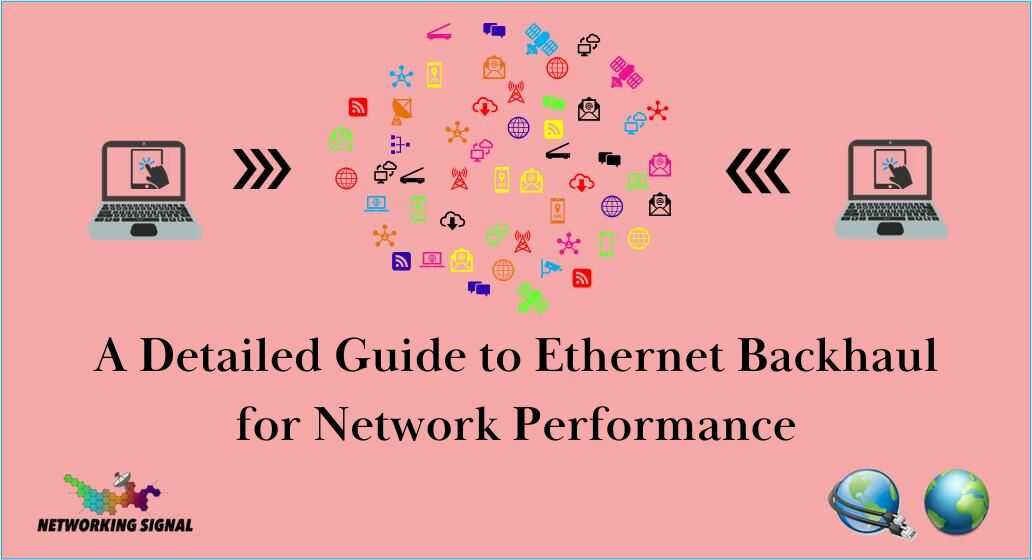Ethernet backhaul refers to using Ethernet technology to connect cell sites in a cellular network back to the core network. It is an increasingly important part of building robust and high-capacity mobile networks as we move into the era of 5G.
With the rapid growth in mobile data usage driven by smartphones, HD video streaming, and other bandwidth-hungry applications, ethernet backhaul helps operators deliver fast, reliable connectivity to subscribers.
The scalability, efficiency, and reliability advantages of ethernet make it well-suited for modern backhaul networks.
It is replacing older legacy technologies like TDM and microwave backhaul. Implementing ethernet backhaul will future-proof network infrastructure to support next-gen 5G capabilities.
What is Ethernet Backhaul?
Ethernet backhaul involves using Ethernet equipment and connections to transfer data between cell towers and the core network. It works by taking the traffic from cellular radios at the cell site and aggregating it into high-capacity Ethernet links.
These links are then used to connect each cell tower to the core network, which is the central hub that manages and routes traffic across the mobile network.
Compared to legacy TDM and microwave backhaul technologies, ethernet offers several important advantages:
- Higher capacity: Ethernet links can easily scale from 100Mbps to 10Gbps, 40Gbps, 100Gbps, and even 400Gbps. This massive bandwidth supports the surging throughput demands of modern 4G/5G cellular networks.
- Cost efficiency: The volume deployment of Ethernet in data centers has steadily driven down equipment prices while performance has increased exponentially. This makes it much more cost-effective compared to maintaining legacy TDM or microwave gear.
- Flexibility: Ethernet allows operators to adjust bandwidth on-demand by upgrading switch/router equipment without laying new fiber or acquiring spectrum. It also seamlessly supports multiple generations of cellular technology like 3G, 4G, and 5G.
- Reliability: Ethernet transport has proven highly robust and resilient in enterprise networks with excellent uptime. It provides durable physical media like fiber optic cabling.
- Future-proof: Ethernet is a ubiquitous standard that will continue evolving with even higher speeds through standards like 400Gbps. It protects operator investments in backhaul infrastructure.
Types of Ethernet Backhaul
Ethernet backhaul can be implemented through either wired or wireless transmission methods:
1. Wired Ethernet Backhaul
- Uses fiber optic cabling to connect cell sites to the core network. Fiber provides virtually unlimited bandwidth capacity over a single strand of glass and the highest reliability.
- Variants include dark fiber (dedicated point-to-point fiber links) or Ethernet-over-fiber services from a network provider.
- Wired Ethernet has the highest capacity for massive throughput, lowest latency, and highest reliability. But it requires the installation of fiber optic cabling which can be challenging.
2. Wireless Ethernet Backhaul
- Uses microwave radio transmission with Ethernet interfaces rather than legacy TDM interfaces.
- Enables Ethernet connectivity without laying new fiber, by upgrading existing microwave links.
- Capacity can be limited by the available wireless spectrum. More prone to interference than fiber, but reliability has improved significantly.
- Wireless Ethernet offers flexibility to upgrade connectivity without new cabling. But has higher latency than fiber optic backhaul.
Overall, wired backhaul with fiber optic cabling is preferred for the best performance and capacity for future growth. But wireless backhaul is a viable option to upgrade legacy microwave links in areas where fiber is not available.
Setting up Ethernet Backhaul
Deploying Ethernet backhaul involves several key steps:
- Planning: Current and projected network traffic requirements must be estimated. Appropriate Ethernet equipment is selected based on expected throughput. Fiber paths between cell towers are mapped out if doing a wired deployment.
- Installing fiber: For wired deployments, high-capacity fiber optic cabling must be laid out between cell site locations and connectivity hubs using either overhead or underground installation.
- Ethernet equipment: High-performance Ethernet switches and routers are installed at cell sites and connected over fiber or microwave radios. Redundant devices are recommended for resiliency.
- Configuration: Ethernet links are configured appropriately for encapsulation, QoS traffic prioritization, multicast, and fine-tuned traffic shaping settings. Robust management and monitoring tools are implemented.
- Testing: Extensive field testing across all components validates low latency, required throughput, and error-free performance before going live. RF interference checks are critical for wireless ethernet links.
- Monitoring: Continuous performance monitoring with management tools ensures network uptime and identifies any throughput or latency degradation indicators. Rapid response to faults.
Proper planning and design is key for a successful Ethernet backhaul deployment. Sufficient capacity, redundancy, and SLAs should be provisioned during the initial rollout to support future bandwidth growth and stringent 5G performance requirements.
Ethernet Backhaul in Action
Ethernet backhaul provides critical connectivity for cellular networks across diverse environments:
- Urban – High-capacity Ethernet over fiber backhaul with 10Gbps, 40Gbps, or 100Gbps links enables blazing fast 5G speeds on city networks with many densely packed cell sites. Supports advanced capabilities like network slicing, and low latency for smart cities.
- Suburban – Cost-effective way to connect macro cell towers spread farther apart. Also provides robust backhaul to smaller cells on light poles, building rooftops, etc. A key enabler for 5G in neighborhoods.
- Rural – Makes high-speed mobile broadband more viable in remote areas by avoiding expensive fiber builds to every single small town or village. Wireless Ethernet efficiently backhauls traffic from rural towers.
Specific benefits include supporting ultra high-bandwidth capabilities like massive MIMO antennas, network densification through small cells, IoT device proliferation, and fixed wireless access. Ethernet backhaul also future-proofs investment as networks evolve from LTE to 5G standalone.
Wrap up
Ethernet backhaul is an essential modern solution to connect current 4G and future 5G cellular networks. Its scalability, cost efficiency, reliability, and ease of management make it the ideal choice over legacy technologies.
Investing in Ethernet backhaul will provide the robust network infrastructure needed for next-gen mobile capabilities like extreme data speeds, massive device density, low latency, and new 5G applications.
Both wired and wireless Ethernet backhaul options empower operators to build advanced networks that can deliver exciting new user experiences and capitalize on new 5G revenue opportunities.

